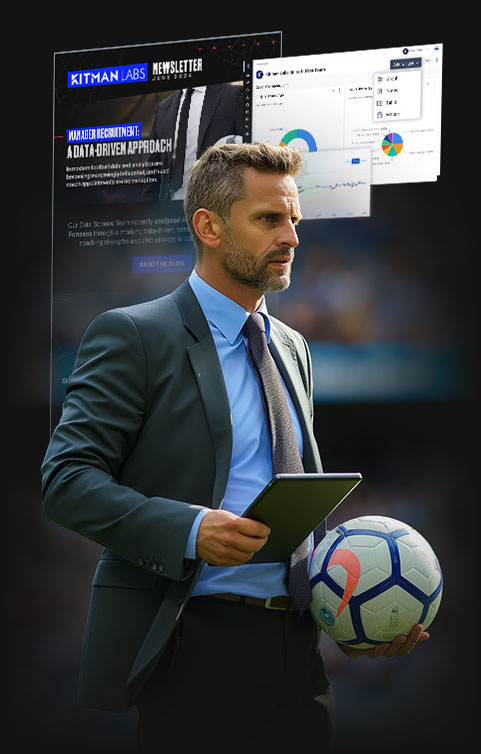Stephen Smith, CEO of Kitman Labs, shares insights on the genesis of Risk Advisor, the value in uniting teams around data, and the power of trust in sports medicine.
What’s the genesis of Risk Advisor?
For me personally, it’s the fruit of fifteen years’ worth of work. Risk Advisor was actually what we dreamed of from the very beginning with Kitman Labs. It was a simple concept: we wanted to understand why people break. And do it from a perspective of evidence, research, and analytics.
Hearing you talk about the Age of Performance Intelligence, there’s always passion and always humility. Did you make mistakes developing Risk Advisor? What lessons did you learn?
Certainly we made assumptions that were incorrect. Everybody wants a silver bullet, but nobody believes a silver bullet is real. Everyone knows the situation is too complex for that. We wanted to build a process that respects the complexity of sport, that lets people in a very easy fashion understand better what’s actually happening with their athletes so they can make better decisions.
Going in, we assumed that across all the data, all teams, all sports, that certain injuries would occur in the same way across cohorts of people. And we found that’s just not true. Different teams in different environments play and train in different ways. Therefore the stress, strain, and stimulus applied to athletes makes them stronger and weaker in different ways – which means they break in different ways.
Yes, human beings are very adaptable. But if you ask a marathon runner to compete in Olympic weightlifting, that athlete is probably going to break. These are fine-tuned machines. Their bodies are used to being stressed in certain ways.At first, this was one of the things we were most surprised about. In hindsight, we were naïve to think there would be a one-size fits all problem – and that’s what makes Risk Advisor so special: we’ve boiled down the data to understand what makes each person unique and empower practitioners to respond with real research they can use in the day-to-day.
I’m sure a lot of others are operating in this space. Why are current solutions just not enough?
Elite sport has been kind of infiltrated by black-box algorithms and snake oil salesmen. They are people who offer just very fragmented analysis. You’ll see an off-the-shelf solution that takes two data sources, draws a relationship between X and Y, and then leap to a conclusion about why somebody tore an ACL.
We believe human beings are far more complex than that. In modern sport, athletes undergo a huge, varied amount of stress and strain in practices, at the gym, during games. There’s a multitude of reasons why people break.
And in this Age of Performance Intelligence, teams are collecting vast amounts of data on how athletes’ bodies respond to those reasons. Just for context, when we started our company in 2008, teams were collecting roughly 95,000 data points per athlete per year. Today, that figure is more than 2.5 million.
We saw teams with all these vast pieces of information, but nowhere to bring it together and turn it into understanding. The purpose of Risk Advisor was to provide that. We wanted to surface the most relevant of those 2.5 million data points, analyze the information for objective insights, and help practitioners understand when people are at an elevated risk for specific types of pathologies – and why. And then help them make decisions to address that.
Risk Advisor holistically captures all of that.
What we’ve seen in the market over the last 10 years is people saying, ‘This piece of information is the goal.’ Take baseball, for example. It’s been all biomechanics. People think ‘If we can understand how the pitcher moves, we can understand whether they’re at risk or not.’ That’s just not true. If that claim was true, every MLB team has already invested in collecting biomechanical data, and so there would be no more elbow and shoulder injuries. There are tons of tools for it, and it’s not that any of this tech is bad. It’s just that any of its impact in isolation is extremely limited.
There’s so much more than just the pitcher’s movement during those hours of game play. There’s how he trains, how he rests, how he sleeps. With Risk Advisor, we’re bringing it all together to allow us to understand cause and effect. What combination of all these pieces makes someone break? Can we recognize them in real time?
This all sounds like it isn’t a sports science problem or a data science problem, but maybe in the middle of that Venn diagram. Is that accurate?
It’s not a sports science problem. It’s not a sports medicine problem. It’s not a coaching problem. Everything you do as an athlete – every piece of information, stress, strain – it all culminates into potential for that athlete to either perform or break. It’s not just the sports medicine team’s job to collect some information in the treatment room that suddenly better helps manage the athlete. They need to understand the impact of practice and game play.
There’s a high degree of data quality and consistency that’s needed across a high-performance organization. You can’t just look at one thin sliver of athlete’s lifecycle and then make huge estimations. We need to look at every facet of what’s happening with that athlete. Therefore the responsibility for data collection falls on everybody, and Risk Advisor helps meet that responsibility.
This is also something that changed for us. When we first started out on this mission, we thought, ‘Okay, let’s get the sports medicine and the conditioning teams together. If we do that, that’s the dream!’ But if coaching staff, performance and analytics staff aren’t involved, you’re not getting the whole picture.
Think of it in terms of an athlete’s daily activities. They probably spend 15 to 20 percent of their time in the gym, 60 percent on the training field, maybe only five to 10 percent in an actual game. If you’re missing practice and game information, you’re operating off a very small slice of information. We’re building a comprehensive understanding of every part of the athlete that every one can access.
So Risk Advisor democratizes information. What’s the value there?
The value is creating shared understanding. Right now, you have people operating in silos of information. In one place, they can see how an athlete moves. In another, how they slept. And still others, how they played, their strength, etc. It’s challenging to understand how all these jigsaw pieces fit together. How do you help a group of staff who all have a core responsibility understand each other’s perspective and how that results in someone’s resilience or risk?
Risk Advisor is all about creating the fabric of that conversation: it’s about turning what once was fragmented data into shared data, and shared data into shared understanding and shared decisions. That’s the continuum we’re trying to drive.
All organizations have huge amounts of data, and it lives all over the place. Even if they’re lucky enough to get it all together in one place, they still can’t turn it into shared understanding. You do that through research, analytics, and communication.
What’s the role of the practitioner’s expertise once all this data is assembled?
The expertise of the practitioner is paramount. None of these tech sources – including ours – will solve their problems. The practitioners will. They’ve spent their careers working these problems. What we’re doing is bringing a level of precision that allows them to do their jobs better.
This is a really powerful distinction: we’re not automating a practitioner; we’re augmenting them.
We’re uniting staff around data and strengthening their instincts with data. From their years of experience, they have these queries, assumptions, and instincts. But what teams can’t do right now is quantify that. We give the tools that allow them to probe and validate or invalidate the assumptions they have.
These people have moments to make decisions. They don’t get the opportunity to sit down and spend days bringing this data together and writing a research paper on this. They have a practice session in 30 minutes, and a game tomorrow, and a coach breathing down their neck who needs to know who is available for it. They have minutes, at best, to make a decision.
And the stakes are so high in professional sport. Your ability to make those decisions accurately is incredibly valuable.
And with the stakes being so high, I imagine it’s tempting for a lot of sports tech companies to say they can predict injury. Does Risk Advisor predict injury?
We don’t believe prediction is possible. We believe in risk assessment. As good as the data sets are in elite sport, human beings are extraordinarily complex. People aren’t supercomputers. We need to understand with as much fidelity as possible what’s going on, but there’s always going to be an element of chance. Risk Advisor helps people understand how good the assessments really are.
It’s not called Risk Predictor; it’s Risk Advisor. We’re providing quantifiable advice that we can stand behind and let practitioners know how confident they can be. We come from a background of evidence. We want them to understand how much trust they can place in us. We’re certainly not sitting here with a crystal ball.
Tell me more about trust. How do you build it with Risk Advisor? What’s the role of trust in the relationship?
Trust is imperative. Go through a day in the life of a head of sports medicine, multiple stakeholders place enormous trust in them. Coaches need to know what a player can and can’t do. Athletes need to understand what’s happening with them – their bodies are their business. Really, for the role of the modern sports medicine practitioner, their entire career revolves around the trust of all stakeholders. It’s the basis of their career.
And we built Risk Advisor in the way we have to give them information they can use as part of their conversations with athletes and coaches to earn trust faster and keep it longer.
A trainer that’s guesstimating is not as good as one who can sit down and explain why an athlete is at twice the amount of risk today versus yesterday. When you can look at all the permutations and let the data tell its own story, you can really understand the granularity of what’s happening. You bring the athlete and the coach along on that journey. And that builds an immense amount of trust.
Fifteen years – it’s been a long journey. You clearly have a role in the elite sport industry’s ongoing quest to reduce injury and help elevate performance. Where do you see the industry going from here?
We’re getting into an age where all practitioners within elite sport can have tools and solutions like this to leverage their information and get intelligence. That’s why I’m always banging on about the Age of Performance Intelligence.
The “Big Data Revolution” is here in sport, but unlike other industries that have been transformed by analytics, the world of sport is very varying in that. What we think we’ll see is every stakeholder being able to answer the most pressing questions through data and intelligence, and doing it from a very research and evidence-based way.
We’re incredibly excited to contribute to that journey, to lead where and when we can, and add value to take this whole enterprise to the next level of performance.




